Table of Contents
Ford Transit
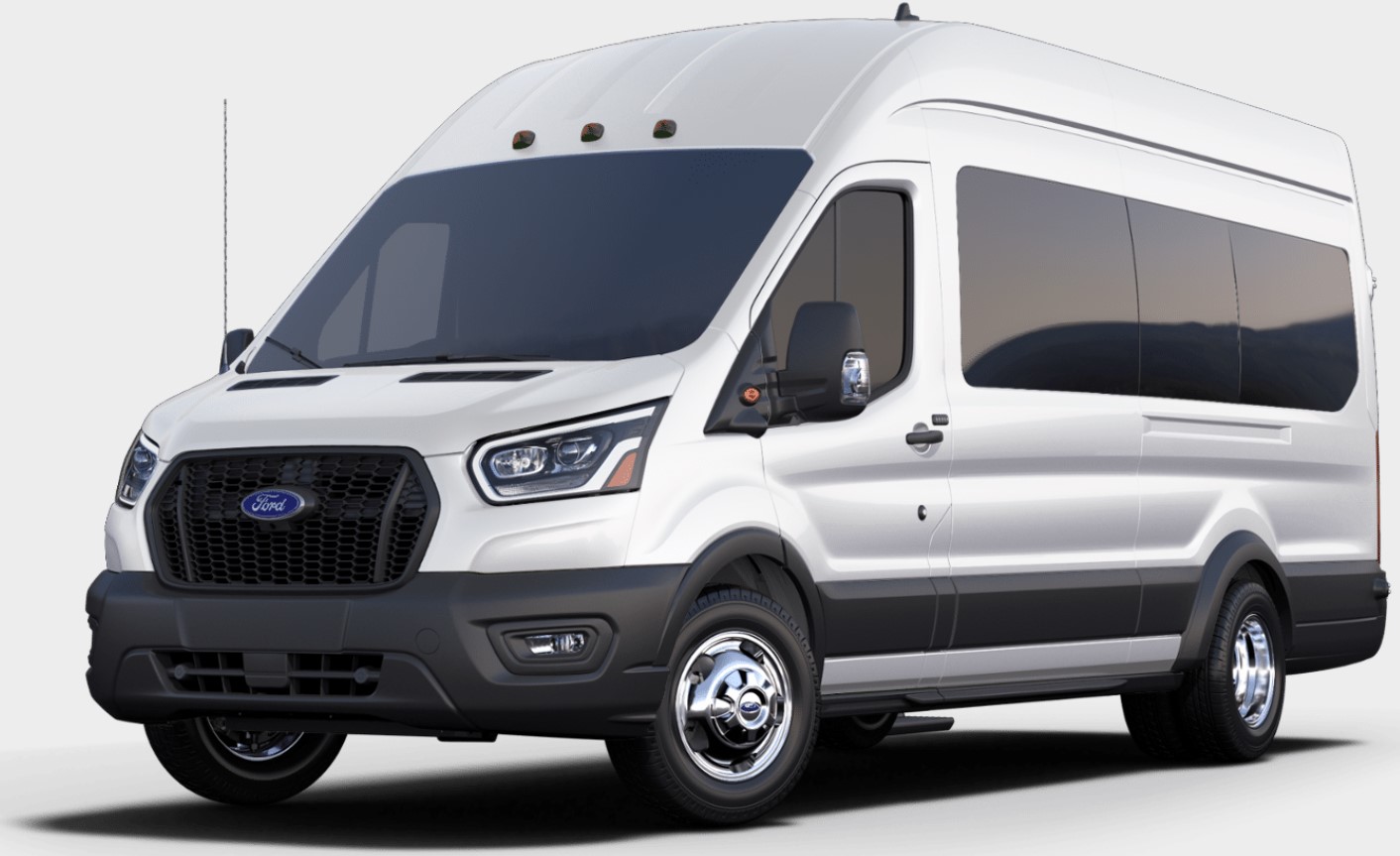 The Transit eurovan has been sold overseas for decades but has only been offered in the US since 2015 as a replacement for the Econoline-series vans. It is currently the best-selling van in the US. Compared to the Econoline, the Transit offers noticeable increases in creature comforts, fuel economy, interior space, height, and build quality, with sacrifices made in towing and off-pavement capability. 1)
The Transit eurovan has been sold overseas for decades but has only been offered in the US since 2015 as a replacement for the Econoline-series vans. It is currently the best-selling van in the US. Compared to the Econoline, the Transit offers noticeable increases in creature comforts, fuel economy, interior space, height, and build quality, with sacrifices made in towing and off-pavement capability. 1)
Facts and Figures
The stock van offered in North America is RWD, but can be ordered as AWD from the factory starting with the 2020 model year. It is available in a dual-rear-wheel (DRW) for GVRWs of 9,950lbs and above.
Beginning in 2023, Ford began offering a “Trail” package for the AWD Transit, which comes with a 2“ factory lift and larger tires that combine to offer a 3.5” increased ride height over the standard van. It comes with an electronic speed limit of 81mph.2)
Dimensions
See this video for a detailed breakdown of all the nuances of interior dimensions
Engine
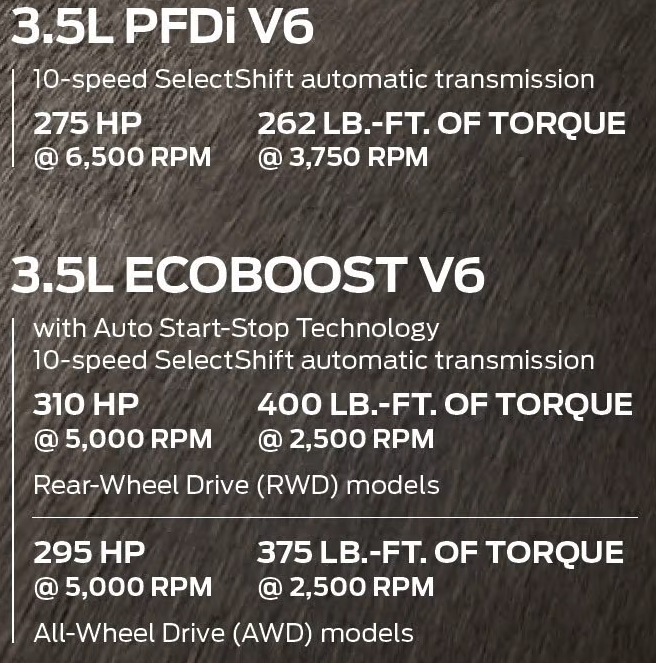 The stock engine is a naturally aspirated V-6 (3.7L for 2015-2019, 3.5L for 2020+), with 3.5L Twin-Turbo Ecoboost and 5cyl diesels available. As of 2022, the diesel is no longer offered and has been replaced with the all-electric E-Transit.
The stock engine is a naturally aspirated V-6 (3.7L for 2015-2019, 3.5L for 2020+), with 3.5L Twin-Turbo Ecoboost and 5cyl diesels available. As of 2022, the diesel is no longer offered and has been replaced with the all-electric E-Transit.
The Ecoboost engine in all model years of Transits is the Gen1 engine, not the Gen2 engine found in the F-150. With 400ft/lbs of torque coming in at just 2,500rpm it is surprisingly punchy and easily motivates even the biggest vans.
Auto-Start-Stop (A.S.S) was mandatory on the engines for 2020-2022, but has been dropped for 2023 due to manufacturing delays and chip shortages.
Drivetrain
From 2015-2019, all engines used the same six-speed automatic transmission. Beginning in 2020, all vans switched to the new 10-speed automatic transmission.
The Transit has been offered with either 3.31, 3.73, and 4.10 rear differentials in either open or mechanical limited-slip options. For the 2022 model year, the 3.31 option was dropped. All factory AWD options use limited-slip differentials.
Ford offers a variety of GVRWs from 8,000lbs-11,000lbs, with dual rear wheels for the 9,950lb, 10,360lb (high roof extended-length passenger vans), and 11,000lb GVRW. The 9,950lb GVRW option is recommended if possible, as keeping the GVRW under 10,000lbs will frequently result in cheaper insurance and registration fees.3)
Roof Height
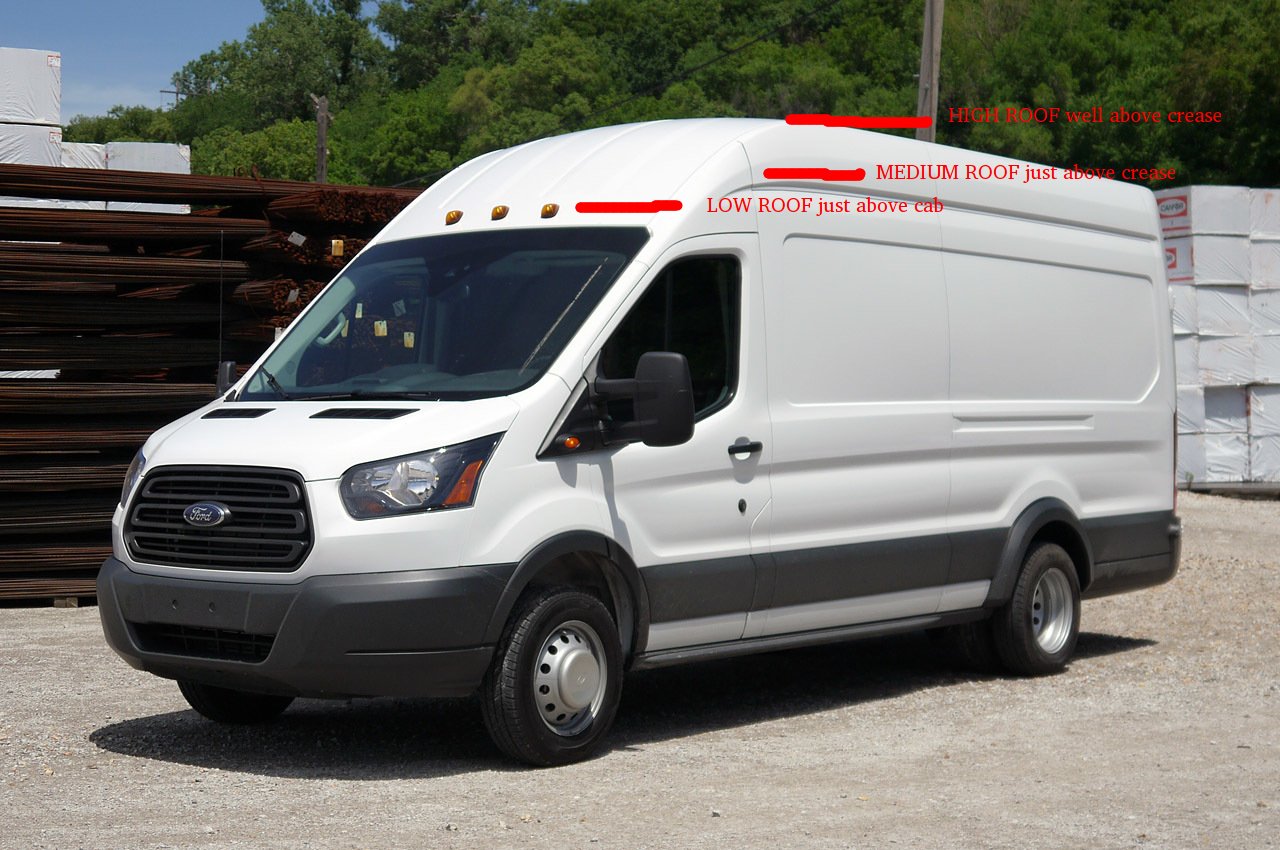 Of particular interest to nomads, the Transit is available in medium roof (70“ to the spar, 72” to sheet metal) and high roof (79“ to spar, 81.5” to sheet metal) on the 250 and 350 models. 4)
Of particular interest to nomads, the Transit is available in medium roof (70“ to the spar, 72” to sheet metal) and high roof (79“ to spar, 81.5” to sheet metal) on the 250 and 350 models. 4)
Low/Medium/High roof models can be identified by looking for the deep crease above the cab line.
- Low roof is just above the windshield and there is no crease.
- Medium roof is just above the crease.
- High roof extends well above the crease.
Wheelbase
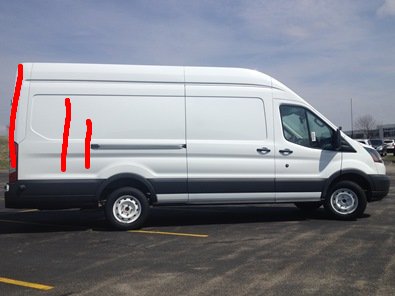 The Transit is available in two different wheel bases, with three different lengths. The wheelbase can be identified be the relationship of the track for the sliding door to the back of the van.
The Transit is available in two different wheel bases, with three different lengths. The wheelbase can be identified be the relationship of the track for the sliding door to the back of the van.
- On the the 130“ Regular Wheel Base (RWB) the rear of the body ends right at the track.
- On the the 148” Long Wheel Base (LWB) the rear of the body extends a bit beyond the track.
- On the the 148“ Extended Length (EL) the rear of the body extends almost a track length beyond the track.
The cargo area lengths are5)
- 103” (Regular 130“ wheelbase)
- 123” (Long 148“ wheelbase)
- 152” (Long 148“ wheelbase, Extended Length).
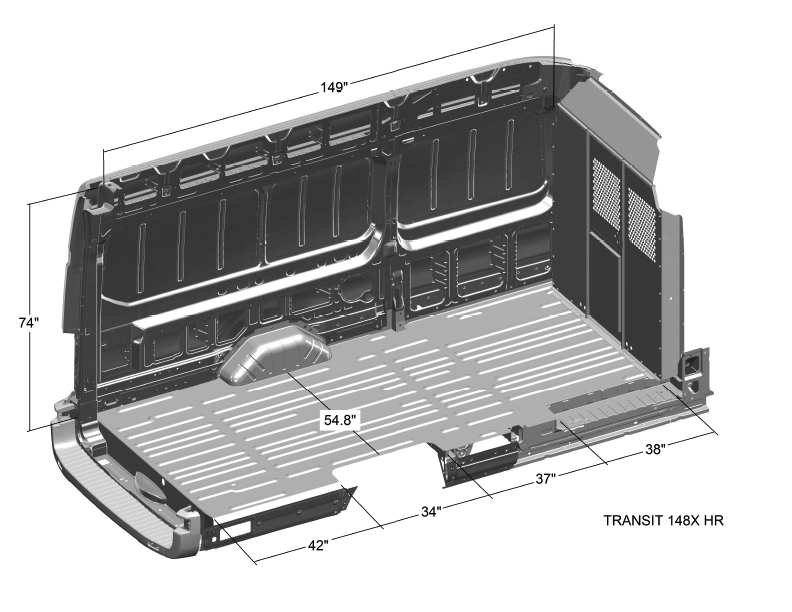 Note that these measurements assume use of a bulkhead. No bulkhead will gain a few inches.Source
Note that these measurements assume use of a bulkhead. No bulkhead will gain a few inches.Source
The Transit's cargo area walls are noticeably straighter than the Sprinter but not as square as the Promaster. The width is about 69”6), tapering to about 62“ just below the roof beams.7) Width between the wheel wells is 53.7” for a single-rear-wheel or 44.5“ for a dual-rear-wheel8). Measured from “skin to skin”9), a maximum width of 74” can be realized.10)
Color
The Transit is offered in a range of greys, with the most common options being white. Passenger vans are commonly black, as they're frequently used as airport shuttles.
Color choice can have a significant impact on interior vehicle temperature, especially for those spending time in warm climates. A Ford dealer lined up a bunch of vans of different colors in the afternoon sun and took the following temperature measurements off the skin:
- Ingot Silver: 113-114
- Oxford White: 118-119
- Other colors: in the 120s
- Carbonized Gray: 142
Interior mounting holes and sizes
The van is Metric, uses metric fastners throughout and all pre-threaded holes are metric. There's no rhyme or reason for how and where they're placed, and the spacing between them is seemingly random.
The majority of the holes in the cargo area of the van are 9.38mm in diameter, and usually work well with M6 or 1/4-20 rivnuts. Most Rivnuts from Amazon fit fine, but some rivnuts (most notably from McMaster-Carr) are actually slightly too large and need a full 10mm hole. The majority of pre-threaded holes are M8x1.25 thread, with a few being M10x1.5. See video here: https://youtu.be/mpoE20subxE
Comparison of Rivnuts vs Plusnuts
While some people have been able to use plusnut into the factory holes, most holes will need to be enlarged slightly.11)
Alternator output
Alternator versions have varied by year, option, and gas v. diesel. Known configurations:
- 210A, 230A, or 250A HD rpm vs current curve
- 2x 250A HD
Aftermarket alternators are available up to 360A.15)
By 2021 at least some of the Transit alternators were “smart” (variable voltage).16) This will affect the voltage available on the CCP (see below).
The Ford Programmable Battery Guard (FPBG) option can vary engine idle to increase alternator cooling when drawing heavy current.17) This option was dropped for the 2022 model year.
Customer Connection Point
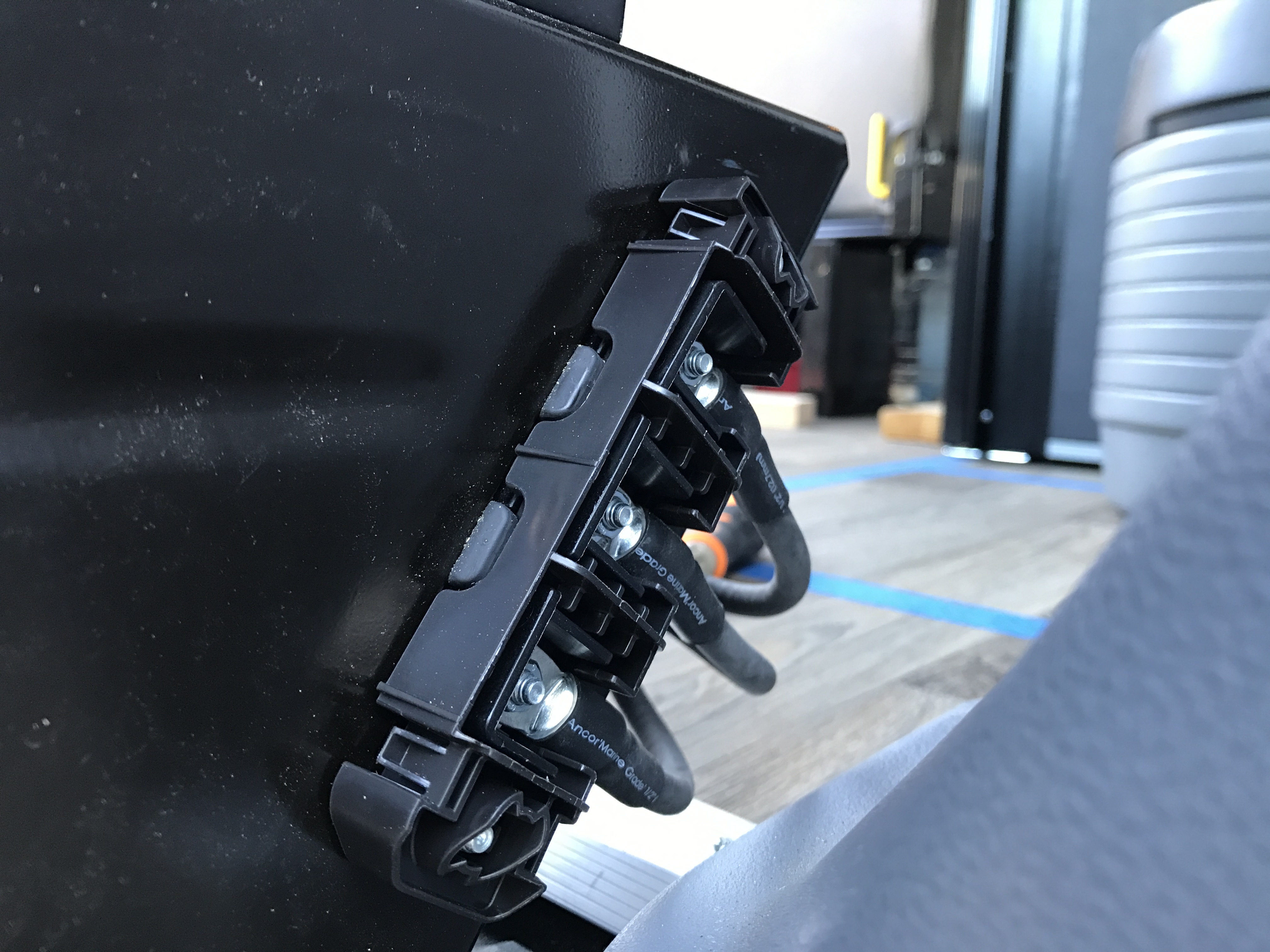 A CCP is a fused chassis power18) distribution point that is optional from the factory by selecting the “Modified vehicle wiring harness” option when ordering a new van.19) This 1-3 CCP20) are mounted in a three-bay bracket; unused bays slots are empty. Vans that came with 1 CCP can be upgraded to 3 using part BK2Z-14S411-A21), allowing for up to 180Ah of total current. See this post for currents >180A.
A CCP is a fused chassis power18) distribution point that is optional from the factory by selecting the “Modified vehicle wiring harness” option when ordering a new van.19) This 1-3 CCP20) are mounted in a three-bay bracket; unused bays slots are empty. Vans that came with 1 CCP can be upgraded to 3 using part BK2Z-14S411-A21), allowing for up to 180Ah of total current. See this post for currents >180A.
Known configurations22) include:
- single 60A CCP (always-hot) on units with a single starter battery
- triple 60A CCP installed with the dual-battery option23)
- single 60A CCP (always-hot) + 120A CCP (ignition-hot, 2x 60A bonded?).
Ignition-hot CCP may also have a timer to allow some runtime after last use.24)
Fuses for the CCP are located under a cover below the driver's seat.25) Battery removal may be required/advised.26) Some add smaller fuses downstream in more accessible locations to avoid having to access/replace the OEM 60A fuses.
Single vs. Dual Rear Wheel
Dual Rear Wheel (DRW) vans offer advantages in load-carrying capacity which can be critical for heavier builds. They can also offer better performance in when driving in conditions with deep sand, gravel and mud (when equipped with proper tires) as the much larger contact patch prevents them from sinking into the surface. The wheel track of DRW vans is 5“ wider than SRW (78.3” for SRW, 83.1“ for DRW) and all DRW vans come with a factory sway bar which gives a more stable and solid feeling when driving on pavement.27) It also offers redundancy and control in the event of a sudden rear tire blowout.
Single-Rear-Wheel vans are preferred for vans that are frequently driven on snowy pavement, as the narrower contact patch can more easily press down through snow to pavement below.
The costs of needing to replace 6 tires instead of 4 is mostly a wash, as the tire sizes used on the DRW are cheaper than the SRW.
The rear valve stems are pain in the butt to access on a DRW van, making airing tires up/down extremely frustrating. Air valve extension hoses are highly recommended.
Notes on AWD (All Wheel Drive)
See the All-Wheel Drive page for information on the limitations of the factory AWD system.
Fuel Economy
There is no appreciable fuel economy savings from the base engine vs the turbocharged “Ecoboost” engine.
The biggest determining factor in highway fuel economy for the Transit is roof height and speed; the high and medium roof vans get significantly worse gas mileage than the low roof models (especially at highway speeds). Community consensus holds that a stock High Roof van with the Ecoboost engine and RWD will get 20mpg at 55mph, 16mpg at 65mph, and 14mpg at 75mph. AWD loses ~1mpg on average. Lift kits and big tires can reduce it further, however the reductions are much less dramatic at lower speeds.
From 2020 onward, all Transits are equipped with a 10-speed automatic transmission that has an extremely deep 10th gear at 0.63:1. This noticeably helps highway mileage.
Roof racks seem to have a significant drag on highway fuel economy, losing 2-3mpg at highway speeds. Empirical testing confirms this.
The Diesel engine does get noticeably better fuel economy (23mpg+ is widely reported at 65mph), however this is offset by their higher purchase cost, more expensive fuel, and long-term reliability problems that are endemic to all modern diesel engines.
Ordering a brand-new Van
FULL DISCLOSURE: This section is mostly a rant about one person's experience trying to custom-order a brand new Ford Transit. It is documented here to serve as a warning to others attempting the same thing.
The ordering process for a new van from Ford is a byzantine, stupid, frustrating process that is a shining example of why people hate car companies.
Remember that you can't actually buy a van from Ford; you have to buy it from a dealership, who acts as a middle-man between you and Ford. In the olden-days this was a useful thing, but in the modern era dealers serve no real function aside from needlessly inflating the cost of vehicles. But because of this, Ford doesn't need to pay very close attention to their website; Remember that to Ford the website only exists to generate leads and send people to dealerships, where they can (theoretically) place an order. You can't actually buy a van on the website.
But because Ford sees the website as little more than a fancy brochure, the website is usually hilariously out of date or incorrect. They didn't even update it for the 2023 Transit until after the ordering window for the Transit had already closed for the 2023 model year. Furthermore, the configuration tool is missing almost all the information you really need to make an informed decision on what you're ordering and will frequently let you “build” a van that isn't actually possible to order due to option incompatibilities or part shortages.
What's worse is that most dealerships aren't particularly knowledgeable about the vans either. The Transit is a very complex vehicle that has more options that almost any other vehicle that Ford makes, and most “salespeople” at dealerships are not hired for their technical knowledge. They exist only to push you into financing and undercoating packages. If you have deep technical questions that you need answered, your only realistic chance is finding a dealership who specializes in commercial and fleet sales, or selling to upfitters. In reality, I found it far easier to simply ask people on the Ford Transit Owner forums.
To really get useful information on what options are what, you need to get the Ford Transit Order guide. Googling can find it, it's usually updated pretty often through the model run and ends up posted all over the Ford Transit USA forums. There's an older version here. You'll also want to get your hands on the BEMM, the Body Equipment Mounting Manual, which has a lot of useful information for upfitters and people who are making modifications to the van. Again you'll need to google for it, as it's model-year-specific and changes locations on Ford's website frequently.
To make it even worse, many dealerships can't even order new Transits; At the beginning of a model year, Ford makes a guess at how many of each type of vehicle it can build and then splits all of those manufacturing slots between all of its franchisees. It does this by giving its dealers an “Allocation” of how many of each specific type of vehicle they're allowed to order. Higher-volume, better performing dealers are usually rewarded with more allocations while problematic dealerships get fewer. Some dealerships that mostly deal in passenger cars and trucks may not get any allocations for Transits at all. (Of course, don't expect the sales people to be honest with you about if they have any allocations. Sometimes they themselves don't actually know; this information is sometimes held closely by the sales managers.)
The dealership has to then decide how many of these allocations to use for “stock” vans that they can order to sit on the lots to use for test drives or impulsive buyers, and how many to hold in reserve for people who want to make custom orders. Once these Allocations are all sold to customers, the dealership can still keep placing orders but it has no assurances that it will actually be built. And at least for the 2021/2022/2023 model years, most dealerships completely sold out of allocations for the upcoming model year by the end of September!
What this means is that the window for being able to order a van and have some sort of hope that it will actually be built is vanishingly narrow; sometimes only being open for a few weeks per year. For the 2023 model year the order window opened on August 24th and closed on September 11th; it was open for just three weeks!
Some of these problems are, in no doubt, due to production limitations brought about by the computer ship shortage and exacerbated by the war in Ukraine; the majority of Ford's wiring harnesses were produced in Ukraine.
But because of this, do not expect that ordering a van will be a simple or fast process; many buyers for the 2022 model year waited 9+ months after placing their orders only to be finally told by the dealership that the order had been “Balanced Out”; Ford-speak for “Canceled”.
Known Issues
This has been moved to the Common Issues page.
DIY Repair/Maintenance
Brakes
Due to the design of the braking system, the rear brake pads on Transits can wear out more quickly than many owners expect. Replacing the brake pads yourself isn't hard, but you will want a Caliper Wind-back Tool.
Removing the rear brake rotors for replacement or resurfacing requires pulling out the axle. Many of the bolts involved are single-use, and must be replaced every time.28) Attempting to re-use the bolts will result in them breaking and the axle taking a horizontal exit from the van.
These are the part numbers and torque specs for the bolts that must be replaced if they need to be removed for service.
- W500540-S442 - Rear Caliper Anchor Plate/Bracket Bolt, Left Qty 2 & Right Qty 2
- 85 ft lb
- W500463-S442 - Front Caliper Anchor Plate/Bracket Bolt, Left Qty 2 & Right Qty 2
- 203 ft lb
- W714650-S442 - Front T50 Torx Wheel Hub Bolts, Left Qty 5, Right Qty 5
- 46 ft lb
- W711141-S442 - Front Brake Rotor/Hub Bolt, 15mm head, Left Qty 5, Right Qty 5
- 22 ft lbs Plus 90 degree additional turn
- W716084-S439 - Rear Brake Rotor/Hub Bolt, 15mm head, Left Qty 5, Right Qty 5
- 46 ft lbs Plus 90 degree additional turn
- BK3Z4A332C - Rear Hub/Axle ORing Seal, Left Qty 1, Right Qty 1
EDIT: There has been some confusion about exact torque specs for the rotor hub/bolts when it comes to SRW/DRW vans. Please verify these numbers before attempting your own servicing.
TPMS Reset
Power Sliding Door Repairs
Common Modifications
Disable Marker Lights
By default, all of the van marker lights (tail lights, side marker lights, indicators) come on every time a door is opened or closed. This can be problematic for vans that are parked up for a long period of time as camper vans, as it's a drain on the engine batteries (not to mention greatly decreases stealth at night).
Disabling it requires an OBDII reader, along with the Forscan software to change values in the Body Control Module. Specifically you need to enable “Police Dark Mode” and then “Silent Mode Option”, which gives an option in the dash menu to turn on Silent Mode (which turns off the entry/exit lights, along with disabling the chimes).
See the Ford Transit Owners Forum thread here. You will need the “Extended License” for Forscan in order to write the values (2-month free trial is available at the website). Exact procedure may differ for different model years of vans, but the above is confirmed to work on 2020+ model years.
Tires
The Transit uses a weird tire size and bolt pattern for the wheels, so aftermarket options are limited.
FarOutRide did an excellent write-up on what the options are for more aggressive off-pavement oriented tires for SRW (Single Rear Wheel) vans: https://faroutride.com/ford-transit-larger-tires-upgrade/
For Dual Rear Wheel vans, tire options are even more limited. The factory tire size is narrower than the SRW vans, at 195/75-R16 (RWD) or 205/75-R16 (AWD). Because of this, the front wheel clearance is not a problem but the limiting factor is space between the rear wheels. Wheel spacers can help give more room in between the rear wheels if you do try and run a wider tire.
Groupthink for DRW owners looking for a little more ground clearance, lift and traction off pavement is a 215/85-R16 tire. These are a common light truck tire and have a multitude of options available that have more aggressive tread for off-pavement use. They are significantly taller than stock, and will greatly increase the final drive ratio as well as throwing off the speedometer and stock MPG calculator. Switching the differential gears to 4.10 (instead of the stock 3.73) will return the final drive ratio to almost identical to factory, and should make the speedo and MPG-meter accurate again.
Owners have reported mixed results with these tire sizes, with some fitting acceptably and some not. Some owners have reported that the Toyo Open Country A/T III or the Goodyear Wrangler Duratrac both run slightly narrow, which is advantageous for fitting the DRW rims. This thread and this other thread on the Ford Transit Forums have more information, as well as pictures from owners.
One of the only aftermarket wheels available for DRW vans is the Method MR901. See this thread for info and pics.
Lifting
The AWD Ford Transit cannot be lifted very much. Van Compass has a good technical overview of exactly why, but the quick answer is that the CV joint of the passenger side front axle is extremely short and will start to bind when it is moved out of its intended range. This can lead to early (and very expensive) failures of the passenger side CV joint. Even if the joint is okay, there's some speculation that the boot being constantly flexed closer to the limits of its tolerances may also lead to early failures. The best way to lift an AWD van is with a Subframe Drop, as it mostly eliminates the worries over the CV joint/boot.
Beginning with the 2023 model year, Ford began offering the “Trail” package on the Transit, which comes with a 2” lift via a subframe drop and larger tires from the factory, giving an total 3.5“ of lift. It is only available on AWD vans, and adds $10,000 to the base price.
The RWD Transit offers more options. There are four different methods of accomplishing a lift, with varying levels of reliability.
Note: The differences in all of these options are how the front end of the van is raised; raising the back end of the van is done the same in all situations (using blocks/spacers or progressive springs). Cost estimates show are to lift both the front and rear.
- Stiffer Springs & Strut spacers
- Cost $1000
- Pros: Cheap
- Cons: Messes up the suspension geometry. Puts more stress on the ball joints which might lead to early failures. Narrows the front end track slightly, and alters the suspension movement range. Can lead to strange or wayward handling, especially on bumpy sections because the wheel has less rebound travel available. Also results in the front wheels being more likely to lose contact with the ground when on very rough terrain.
- Can result in expensive damage to AWD vans (see above).
- Some of the lift kits for AWD vans are slightly less than 2” which should theoretically prevent the CV joint from binding, however it is still being used very close to the limits of its range of motion for extended periods of time. This can make failures more likely.
- Replacement Control Arms
- Pros: Maintains proper steering angle, suspension geometry, and wheel path travel.
- Cons: More expensive to buy, and more complicated to install. Bushings may not be serviceable, meaning that worn out bushings could require replacing the entire replacement control arm.
- Can result in expensive damage to AWD vans (see above).
- Lift Spindles
- Cost: $2,500 + Installation
- Pros: Largest possible lift, gives maximum clearance in between the front wheels. Raises the van by 3“, and can be combined with replacement control arms to give a total of 5” of lift. Maintains proper geometry. Allows fitment of very large tires.
- Cons: Expensive. Requires swapping out the ball joints, adding additional cost and difficulty to installation.
- Cannot be installed on AWD vans
- Sub-Frame Drop
- Cost: $3,500-$3,700, including installation. Beginning with the 2023 model year, this is offered as a factory option (via the “Trail” package)
- Pros: The only proper way to lift a factory AWD van that will not result in potential damage to the CV joint. The entire suspension system is unchanged, making any potential maintenance or warranty work from Ford much easier to accomplish. Handling will be identical to factory.
- Cons: Very expensive and still only gives a 2“ lift. Needs to be professionally installed by approved installers. Doesn't increase ground clearance in between the front wheels.
Airbag Lift
Mostly useful for Extended body vans which easily scrape the rear bumper on the ground due to the very long overhang. An Airbag kit can temporarily raise the rear end of the van by 2-3”, which helps a lot in terms of clearing the rear end. See a review here.
Awnings
Low and medium roof Transits will need an awning that is mounted to the roof or a roof rack, taking advantage of the factory roof rack mounts. The Fiamma F80s is an example of a full-feature awning.
High roof Transits typically use a wall-mounted awning to the side of the van. This will require drilling holes in the van body. FarOutRide has probably one of the best installation guides on how to do this. It is possible to mount an awning to a roof rack on a high-roof van, but then the awning is nearly ten feet off the ground which can make it hard to access to extend/retract.
Roof Fan
The Transit's roof is slightly bowed with stiffening grooves spaced every 15“. This can make installing a roof-mounted vent fan complicated, as the fan bases for RV standard 14”x14“ holes are flat and the roof is not.
To compensate for this, you need to use an adapter plate such as made by DIYVan: https://diyvan.com/products/ford-transit-high-mid-roof-vent-adapter. This will sit in between the fan mount and the roof, and give a good mating surface to use with plenty of sealing material such as butyl tape or window weld. A good video with instructions for how to use one of these adapters to install a van can be found here: https://www.youtube.com/watch?v=5rkETMx6_Iw
Windows
Windows can be added to a cargo van for additional light, ventilation, or both. If you are replacing factory-installed windows with aftermarket windows (for example, to get windows that open for ventilation), use caution when ordering as not all aftermarket windows will fit into the factory cutouts (some are smaller)
Windows are a huge source of heat loss or heat gain in the summer. If you're adding windows to your van, make sure you also invest in some kind of shades or covers for them. Some links are here.
Replacing factory windows is a pain in the butt. The factory windows are glued in, making them difficult to remove without scratching up the paint. Some people find it easier to simply break the factory windows (covering them with sticky tape first to minimize the mess), but using an oscillating saw and wire cutting kit it is possible to get them out intact. See this old video from Mercedes on how. Alternately, professional shops will usually swap customer-provided windows in for ~$200 each.
Installation of aftermarket windows into cargo vans without factory windows is similar in difficulty to installing a roof vent (probably easier as you don't have to climb up onto the roof) and can be DIYed.
If you are adding windows to get some additional ventilation, one option is to install the factory Ford windows from prior model years. From 2015-2019, pop-out windows were offered as an option from the factory on the window in the sliding door, behind the driver, and in the rear quarter-panel windows for the Extended-length body. This option was removed for model year 2020. 29) But there have been no changes in the Transit's body around the windows since it was introduce in 2015, so a pop-out window from any model year should fit into any van. You can see about finding one from a scrapyard, or ordering a new window through a dealer. Part numbers can be found here. Pay attention to the color, “Privacy Glass” means the Dark Grey Tint.
Aftermarket windows offer larger opening areas and sometimes have integrated screens. Van Window Direct (VWD) and Campervan-HP offer a range of selections, however not all of them will fit the factory cut-outs.
Aux heater/Fuel Line
While Ford does offer the factory option of an auxiliary fuel line pick up intended for use by aftermarket devices that need to draw fuel from the gas tank, this line is too wide to be used with low flowing devices such as auxiliary heating units.
Instructions for removal of the tank and sender for installation of a smaller line can be found here: https://www.fordtransitusaforum.com/threads/espar-m2-b4l-transit-install-standpipe-install-webasto-vs-espar.88175/
Propane Tank Mount
 On the Extended Transit, the area behind the rear diff is a popular place to install a 5.9 gallon propane tank.
On the Extended Transit, the area behind the rear diff is a popular place to install a 5.9 gallon propane tank.
Install thread is here, and details including schematics to cut your own mounting bracket are here.
Headliner shelf
A convenient stash spot for mid and high roof vans. If you have the factory headliner storage cubbies, some brackets will allow you to make your own larger shelf above the factory ones. https://vancillary.com/products/ford-transit-headliner-shelf-diy-kit
Locking Differentials
Some have had success when installing the electronic locking differential from F-150s into the Transit.
Air lockers are available, but then require installing an air compressor system into the van as well.
Rear Sway Bar
The passenger vans and all dual-rear-wheel vans come with rear sway bars, but the single-rear-wheel cargo and crew vans don't. Sway bars fight the tendency of the rear wheels to move independently of each other, and prevents the van from leaning as much in corners. This leads to much more stable handling on pavement, at the expense of a rougher ride off pavement.
Adding a sway bar isn't difficult, but is made much easier with a lift. The following parts will be needed:
- Stabilizer Bar – CK4Z-5A772-D x1
- Stabilizer Link – BK3Z-5C486-A x2
- Stabilizer Bar Bushing – GK2Z-5493-B x2
- Stabilizer Bar Bracket - BK3Z-5B484-A x2
- Stabilizer Link Bolt – W500745-S442 x2
- Stabilizer Link Washer – W715542-S442 x6
- Stabilizer Link Nut – W520214-S440 x2
- Stabilizer Bar Nut – W716275-S442 x4
- Stabilizer Bar Screw – W500633-S442 x4
4-wheel-drive
4-wheel-drive conversions are offered by Quadvan or Quigly Vans on 2019 and earlier Transits. They cannot be fit to the 2020 and newer vans, as the 10-speed transmission doesn't give enough room for a proper transfer case.
Expect to pay $15-25,000 to have a stock RWD van converted to 4-wheel-drive.
Other Modifications
Center console replacement
Can make going back and forth between the drivers seat and the back of the van easier if you swap in the "slim" center console.
Quirks
Sections of the van body above the doors (and parts of the chassis) are made from boron steel, which is incredibly strong and difficult to drill into. Unless you have a lot of patience and some very specialized drill bits30), it's best to avoid trying to drill into these sections.
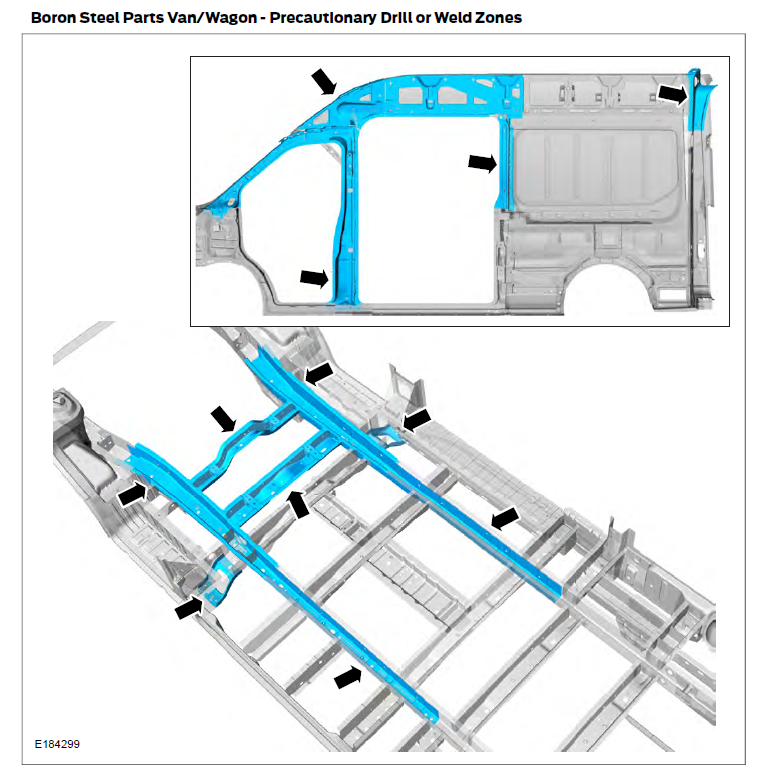 From the BEMM (Body Equipment Mounting Manual)
From the BEMM (Body Equipment Mounting Manual)
The Transit is uni-body, meaning that not all frame/body locations have a reliable and solid path back to a ground. Trying to source a ground from random places on the van can lead to strange electrical problems that are a nightmare to resolve.
To avoid these problems, always use one of the grounding points as supplied and recommended by Ford:
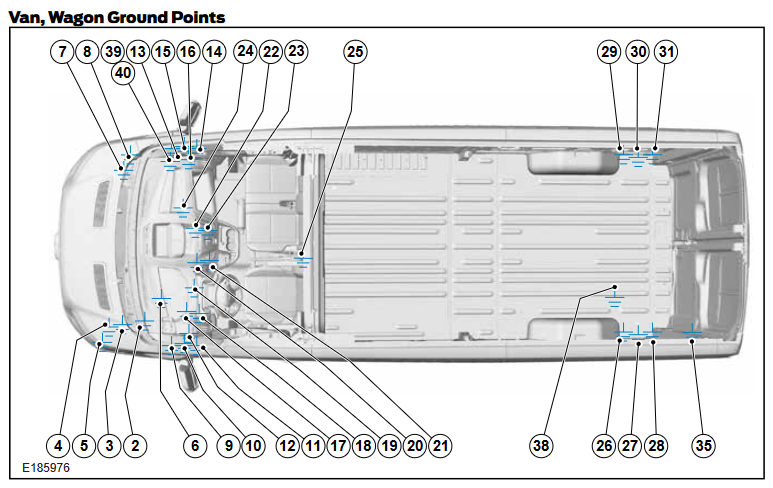
Other quirks:
- The brake pedal is ~2” higher than the gas pedal. Owners report it feels weird at first but they get used to it.
- The rear shock mounts hang strangely low off of the rear axle and can easily be damaged when in bumpy off-pavement situations. Rear Shock Mount Relocation kits are common, however they must be installed in conjunction with a suspension lift.
- The factory AWD system can shut down if driven in difficult conditions for more than 1-2 minutes.
- This isn't a problem, so much as an inherent limitation of AWD.
- The High Roof model is really freaking tall at 9'3“ in factory spec.
- This is too tall to fit through most drive throughs. Vans with damages to the front roof line are common due to people smacking them into stuff; make sure to inspect this area very carefully when buying a used van to check for evidence of repairs.
- The Transit Trail (available from 2023 onwards) is electronically speed limited to 81mph
- This is due to the factory 3.5” lift and off-road oriented tires.
- The vans have a high parasitic draw, Ford claims 50ma but some have measured higher.
- Especially on newer vans with lots of electronics and cellular modem/anti-theft, users with single batteries have reported the van can completely discharge itself in as little as 7-10 days. 5w solar battery maintainers are recommended.
- The Extended-length vans have a very long rear overhang which makes it very susceptible to dragging the rear end on the ground when going over even small incline change, especially if equipped with the factory tow hitch.
- For owners looking for more rear end ground clearance but still need a hitch receiver, and integrated bumper can gain you a few more inches.
- Airbag lift kits can also be installed fairly easily, and are useful for being able to temporarily boost up the rear of the van by a few inches when needed.
- The 2020+ vans have “Smart” alternators which can cause problems for some house battery charging systems which depend on the changes in vehicle voltage to tell them when the engine is running or not.
- To get around this, chargers such as the Renogy DCC50S use a signal wire. Here's some thoughts on the best way to hook this up.
- OEM backup camera is mounted low and in a rear door, limiting usefulness in 2019 and earlier vnas.31) It may be easiest to mount an aftermarket backup camera in the 3rd brakelight up high. For 2019 and newer vans, the factory camera is already mounted up high at the third brake light.
- The rear brake pads wear out very quickly, with some users reporting 20,000 miles in between changes.
- This isn't a defect as much as it is an intentional design decision; in order to reduce front-end dive under braking, the Transit directs most of the initial braking force to the (smaller) rear brakes and only uses the front ones in harder stop situations.
- The Power Sliding Door (an option from 2020 onward) will close very slowly if left open for more than 2 minutes. This is intentional as a safety decision from Ford.
- The Power Sliding Door takes a lot of power and can rapidly drain the vehicle battery.
- Some owners have reported that it will drain the battery to below the level needed to start the van after as few as ~10 cycles with the engine off. It is highly recommended that owners ordering a van with a power sliding door should also order the factory dual battery option.
- “The Blobs”
- There are two large black “blobs” of Styrofoam at the front upper corners of the cargo area, in between the metal body of the van and the cab headliner. Ford uses some pretty strong language in the BEMM that these blocks are not to be modified without prior written permission from Ford; speculation is that they are critical in making sure that the side curtain airbags deploy properly. Many owners cut or modify them as part of their build, and some RV manufacturers (such as Winnebago) remove them completely.
- Body Panels aren't attached to the interior in some places
- Some of the sheet metal braces between the interior walls and the exterior shell will separate, as seen in this video.
- Not actually a problem. These braces are not intended to be welded, they provide stiffness only with pressure against the exterior skin and the glue is there only to hold on the sections of foam rubber that prevents the braces from rubbing a hole in the exterior shell.
- This looseness is intentional, as it allows for thermal expansion/contraction of the skin separate from the interior structural framing. Discussion thread here.
Direct-injected engines like the EcoBoost 3.5 available in the Transit can experience carbon build-up on the intake valves. Although uncommon in normal use, it could be more common for vandwellers (see below) and requires removal of the head to address:
“The only Ford-approved course of action at this time is to replace the cylinder head, though he also said, “Manual cleaning with a brush and various carbon dissolving products has been used with great success on vehicles out of warranty.”32)
Fouling is worsened by running the engine at less than full temperature, which vandwellers may encounter when idling for long periods to charge from the alternator. Using known-quality fuels with minimal contaminants may help minimize the deposits.
The 2nd-generation 3.5 EcoBoost (not yet available in the Transit) addresses this issue by adding port injection to the direction injection:
The port fuel injection was partly added due to the fuel output needs on the 3.5L HO Raptor engine, but also has several benefits for the 3.5L EcoBoost. It will prevent buildup on the intake valves and keep them clean due to fuel passing over the valves. Under certain engine conditions such as low rpm and low loads the high-pressure fuel pump and direct injection system will turn off and the engine will only use the port fuel injection33)
The EcoBoost may shudder or enter limp mode in extremely humid conditions.


